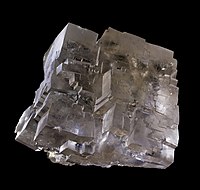
Photo from wikipedia
The process of ice formation in shallow waterbodies can increase chloride to toxic levels in waterbodies already impacted by chloride loading from road salt (NaCl deicer) application. Chloride concentrations were… Click to show full abstract
The process of ice formation in shallow waterbodies can increase chloride to toxic levels in waterbodies already impacted by chloride loading from road salt (NaCl deicer) application. Chloride concentrations were measured bi-weekly in a shallow, urban wetland in Madison, Wisconsin. We found that in this shallow waterbody, ice thickening doubled chloride concentrations from ion exclusion as the water froze. To understand the role of ice formation and ion exclusion, we constructed a numerical model to predict chloride concentrations beneath the ice resulting from ion exclusion. Where chloride levels already are elevated above background and flushing rates are low, ice thickening can push concentrations well above toxicity thresholds for much of the winter. The compounding effects of road salt runoff and ice formation should be considered in the management of water quality and ecosystem health in shallow urban water bodies or waterbodies receiving road salt runoff from nearby roadways.
Journal Title: Limnology and Oceanography
Year Published: 2017
Link to full text (if available)
Share on Social Media: Sign Up to like & get
recommendations!